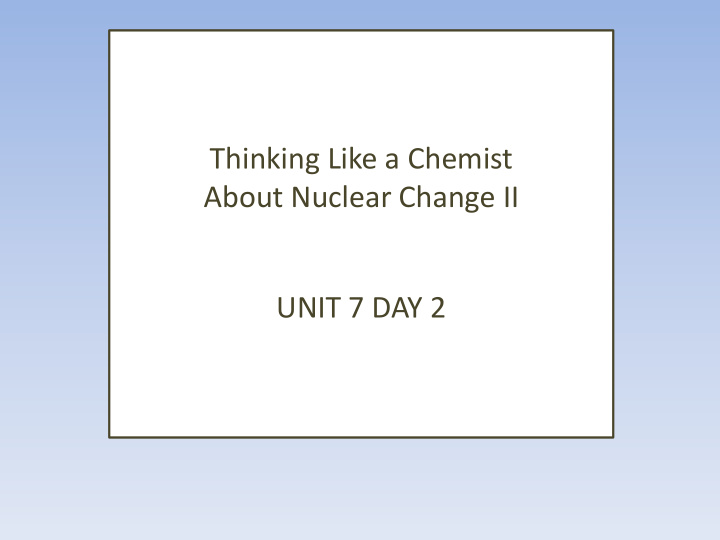



Thinking Like a Chemist About Nuclear Change II UNIT 7 DAY 2
What are we going to learn today? Types of Nuclear Changes Isotopic Stability Ionizing Radiation
Review From Last Class: Nuclear Change vs. Chemical Change 1. Compare energy released upon change 2. Compare what is conserved across the change 3. Types of change and how to recognize type of change
Chemical Change vs. Nuclear Change 4C 7 H 2 (NO 2 ) 3 CH 3 (s) +25O 2 (g) 32CO 2 (g)+10H 2 O(g) + 6N 2 (g) Chemical – atoms rearrange, but do not change atomic identity . 92 U 141 1 0 n + 235 56 Ba + 92 36 Kr + 3 1 0 n Nuclear – nuclear change, change in atomic identity likely across nuclear change, matter converted to energy or energy converted to matter.
START WORKSHEET
Recognize Different Types of Nuclear Change: How are the following similar and different? 92 U 234 238 90 Th + 4 2 He 92 U 141 1 0 n + 235 56 Ba + 92 36 Kr + 3 1 0 n
Fission vs. Fusion – make it happen 92 U 141 1 0 n + 235 56 Ba + 92 36 Kr + 3 1 0 n 1 H 3 1 1 H + 2 2 He
Transmutation – make it happen 2 He 17 14 7 N + 4 8 O + 1 1 H 2 He 30 27 13 Al + 4 15 P + 1 0 n
Radioactive Decay – just happens 92 U 234 238 90 Th + 4 2 He + 2 0 0 γ 90 Th 234 234 91 Pa + 0 -1 e 11 Na 22 22 10 Ne + 0 1 e -1 e 201 201 80 Hg + 0 79 Au + 0 0 γ
BACK TO THE WORKSHEET For question 3, express the energy change in J/mol
Where does the energy come from? BINDING ENERGY – WHAT IS IT? HOW IS IT RELEASED?
Binding Energy per Nucleon CH302 Vanden Bout/LaBrake Spring 2013
What did we learn today? Types of Nuclear change: Fission Fusion Decay Transmutation CH302 Vanden Bout/LaBrake Spring 2012
IMPORTANT INFORMATION LM 24 & LM 25 Check out nuclear reaction and decay worksheets.
Recommend
More recommend